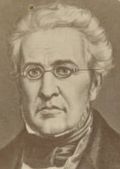 |
Lucas Ignacio José Joaquín Pedro de Alcántara Juan Bautista Francisco de Paula Alamán y Escalada
b. 18 Oct 1792, Guanajuato
d. 2 Jun 1853, Mexico City |
| Title: |
Miembro del Supremo Poder Ejecutivo Provisional (Member of the Provisional Supreme Executive Authority) |
| Term: |
23 Dec 1829 - 1 Jan 1830 |
| Chronology: |
23 Dec 1829, executive power is transferred to the Provisional Supreme Executive Authority in accordance with Art. 97 of the Constitution of 1824, resolution of the Consejo de Gobierno (Council of Government), session of the Council of Government [1] |
| |
23 Dec 1829, elected and took an oath of office, session of the Council of Government [1] |
| |
1 Jan 1830, Provisional Supreme Executive Authority ceased to function upon the installation of a successor [2] |
| Names/titles: |
Baptised (20 Oct 1792): Lucas Ignacio José Joaquín Pedro de Alcántara Juan Bautista Francisco de Paula [3] |
| Biography: |
| Born into a wealthy family involved in the mining industry; received his early education in Guanajuato; attended the school of Belen; studied mathematics and other branches in the Colegio de la Purísima Concepción; witnessed the slaughter of Spanish population of Guanajuato by indigenous forces of Miguel Hidalgo (1810); studied at the Colegio de Minería (School of Mining) in Mexico City; completed his education with a tour of Europe, learning latest mining techniques, chemistry, and languages; was elected to the Cortes of the Spanish monarchy as a deputy for the Province of Guanajuato (1821-1822); took his seat on 2 May 1821; served as secretary of the Cortes (28 Oct 1821 - 28 Nov 1821); was granted leave of absence to return to Mexico (9 Feb 1822) and left the Cortes after the closing of a session on 14 Feb 1822; after visiting some European countries, he returned to Mexico in 1823; served as minister of internal and external relations (1823-1824, 1824-1825) under a provisional executive (Supremo Poder Ejecutivo) and Guadalupe Victoria; resigned ministerial post after confrontations with federalists in the Congreso; withdrew from public life until 1829, when he was appointed as a member of the Supremo Poder Ejecutivo Provisional (23 Dec 1829 - 1 Jan 1830), a committee set up after the coup d'état of 23 Dec 1829, pending the arrival of Vice President of the Mexican United States Anastasio Bustamante to the capital; again assumed the office minister of internal and external relations (1830-1832) in the administration of Bustamante; signed a treaty of limits with the United States, which ratified the borders established in the Adams-Onís Treaty in 1819; founded the Banco de Avío para Fomento de la Industria Nacional (1830), a government-sponsored institution which offered loans to assist modernization of industry; was the founder of the National Museum and the General Archive in Mexico City; during the radical administration of Valentín Gómez Farías, he and other former cabinet ministers in the Bustamante government were accused of complicity in the murder of Vicente Guerrero; was ordered to be detained and went into hiding (1833); emerged from concealment in 1834 during the presidency of Antonio López de Santa Anna; was exonerated of all accusations by the Supreme Court of Justice (17 Mar 1835); refused to take seat as a representative of Guanajuato in the Cámara de Diputados (18 Apr 1835); served as a member (16 Jan 1837 - 6 Oct 1841) and vice-president (16 Jan 1837 - 10 Jan 1841) of the Consejo de Gobierno in the period of the Centralist republic; received one vote cast by the departmental junta of Nuevo León at the election of the President of the Republic in 1837; published important historical works Disertaciones sobre la historia de la República mexicana (1844-1849) and Historia de México (1848-1852); was appointed a member of the Junta de representantes de los departamentos (Council of the Representatives of the Departments) summoned to elect Interim President of the Republic (3 Jan 1846); served as a member of the Congreso Nacional Extraordinario (1846) from the Department of Mexico; was a founder of the Partido Conservador (Conservative Party) in 1849; became the chief Conservative theorist and spokesman; edited Conservative newspapers El Tiempo (1846) and El Universal (1848-1853); elected to the Cámara de Diputados as a representative of Jalisco (1849-1851); was named minister of external relations in the cabinet of López de Santa Ana (1853) but died shortly afterwards. |
| Biographical sources: birth and baptismal record in Archivo de la Parroquia de Nuestra Señora de Guanajuato, Bautismos de españoles 1791-1793, fol. 172 (printed version of this record appears in "Juárez y sus contemporáneos", by Jorge Fernández Ruiz and Manuel Germán Parra, Mexico: Universidad Nacional Autónoma de México, 2006, p. 66); death and burial record in Distrito Federal, Asunción Sagrario Metropolitano (Centro), Defunciones 1849-1853, #473, fol. 73; "Proceso instructivo formado por la seccion del Gran jurado de la Cámara de diputados del Congreso general: en averiguacion de los delitos de que fueron acusados los ex-ministros d. Lucas Alaman, d. Rafael Mangino, d. Jose Antonio Facio y d. Jose Ignacio Espinosa" (Mexico: Impreso por Ignacio Cumplido, 1833) (web site) |
| |
| [1] |
Colección de las leyes 1829-1830, p. 85. |
| [2] |
The term of the Provisional Supreme Executive Authority is deemed to have expired on the day when Vice President of the Mexican United States Anastasio Bustamante issued a manifesto (dated 1 Jan 1830, Mexico City), proclaiming the assumption of executive authority (El Sol, No. 186, 2 Jan 1830, p. 741). |
| [3] |
Baptismal record was made 20 Oct 1792, stating that the child was born three days ago, thus placing the birth either on 17 or 18 Oct 1792. |
| |
Image: Cruces y Campa Collection, Latin American Library, Tulane University. |

